air condition TOYOTA PRIUS C 2014 NHP10 / 1.G Owner's Guide
[x] Cancel search | Manufacturer: TOYOTA, Model Year: 2014, Model line: PRIUS C, Model: TOYOTA PRIUS C 2014 NHP10 / 1.GPages: 563, PDF Size: 8.89 MB
Page 348 of 563
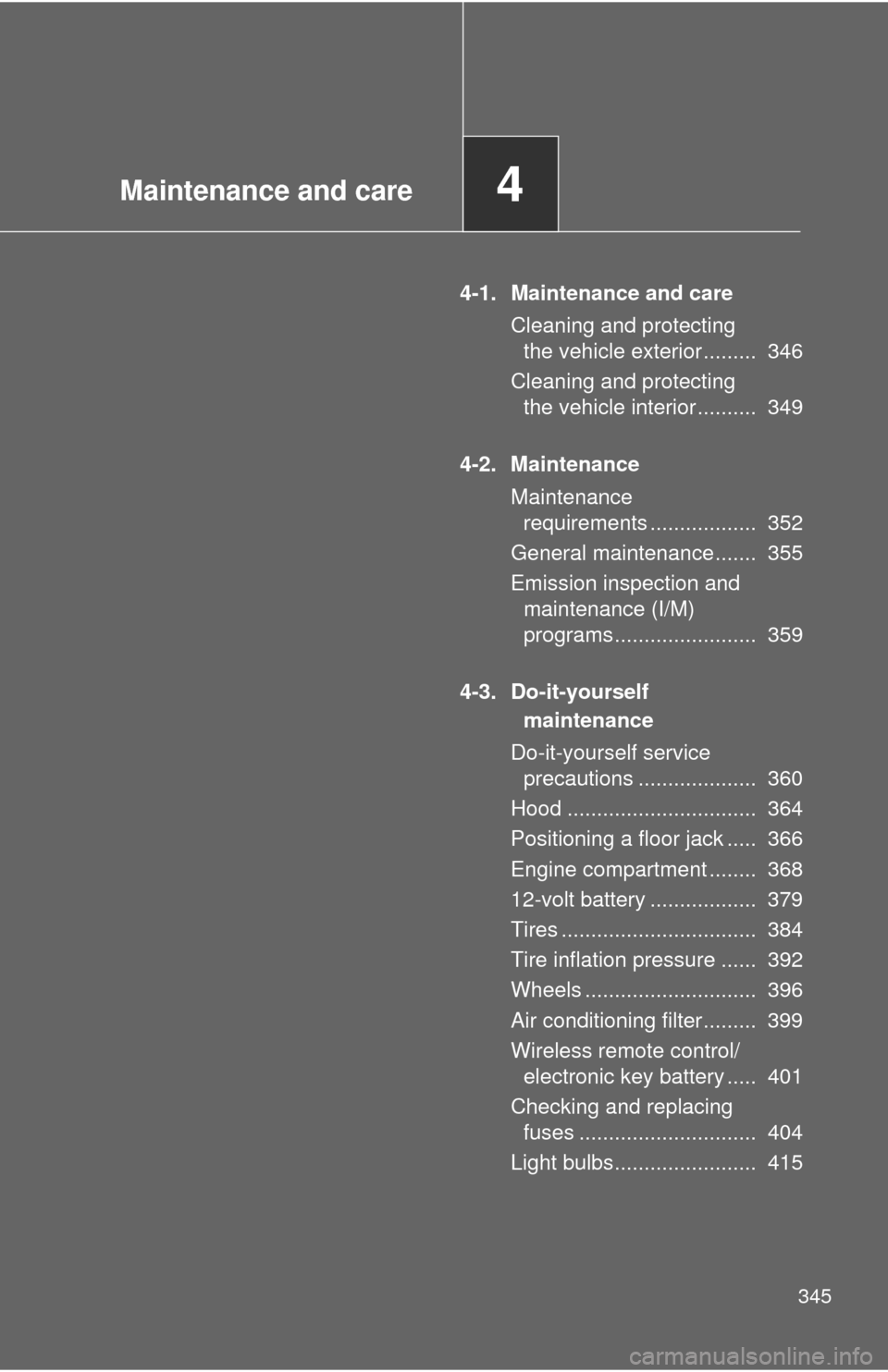
Maintenance and care4
345
4-1. Maintenance and careCleaning and protecting the vehicle exterior ......... 346
Cleaning and protecting the vehicle interior .......... 349
4-2. Maintenance Maintenance requirements .................. 352
General maintenance....... 355
Emission inspection and maintenance (I/M)
programs........................ 359
4-3. Do-it-yourself maintenance
Do-it-yourself service precautions .................... 360
Hood ................................ 364
Positioning a floor jack ..... 366
Engine compartment ........ 368
12-volt battery .................. 379
Tires ................................. 384
Tire inflation pressure ...... 392
Wheels ............................. 396
Air conditioning filter......... 399
Wireless remote control/ electronic key battery ..... 401
Checking and replacing fuses .............................. 404
Light bulbs........................ 415
Page 365 of 563

362 4-3. Do-it-yourself maintenance
CAUTION
The engine compartment contains many mechanisms and fluids that may
move suddenly, become hot, or become electrically energized. To avoid death
or serious injury, observe the following precautions:
■When working on the engine compartment
●Vehicles without a smart key system: Make sure that the engine switch is
in the “LOCK” position and the “READY” indicator is off.
Vehicles with a smart key system: Make sure that the indicator on the
“POWER” switch and the “READY” indicator are both off.
● Keep hands, clothing and tools away from the moving fan and engine
drive belt.
● Be careful not to touch the engine, power control unit, radiator, exhaust
manifold, etc. right after driving as they may be hot. Oil and other fluids
may also be hot.
● Do not leave anything that may burn easily, such as paper and rags, in the
engine compartment.
● Do not smoke, cause sparks or expose an open flame to fuel. Fuel fumes
are flammable.
■ When working near the electric cooling fan or radiator grille
Vehicles without a smart key system: The electric cooling fan may keep
rotating for about 3 minutes even after the engine switch is turned to the
“LOCK” position.
With the engine switch in the “ON” position, the electric cooling fan may
automatically start to run if the air conditioning is on and/or the coolant tem-
perature is high. Be sure the engine switch is in the “LOCK” position when
working near the electric cooling fan or radiator grille.
Vehicles with a smart key system: The electric cooling fan may keep rotating
for about 3 minutes even after the “POWER” switch is off.
With the “POWER” switch in ON mode, the electric cooling fan may automat-
ically start to run if the air conditioning is on and/or the coolant temperature
is high. Be sure the “POWER” switch is off when working near the electric
cooling fan or radiator grille.
Page 394 of 563

391
4-3. Do-it-yourself maintenance
4
Maintenance and care
NOTICE
■Repairing or replacing tires, wheels, tire pressure warning valves,
transmitters and tire valve caps
●When removing or fitting the wheels, tires or the tire pressure warning
valves and transmitters, contact your Toyota dealer as the tire pres-
sure warning valves and transmitters may be damaged if not handled
correctly.
●When replacing tire valve caps, do not use tire valve caps other than
those specified. The cap may become stuck.
■To avoid damage to the tire pressure warning valves and transmit-
ters
When a tire is repaired with liquid
sealants, the tire pressure warning
valve and transmitter may not operate properly. If a liquid sealant is
used, contact your Toyota dealer or other qualified service shop as soon
as possible. Make sure to replace the tire pressure warning valve and
transmitter when replacing the tire. ( P. 385)
■Driving on rough roads
Take particular care when driving on roads with loose surfaces or pot-
holes.
These conditions may cause losses in tire inflation pressure, reducing
the cushioning ability of the tires. In addition, driving on rough roads may
cause damage to the tires themselves, as well as the vehicle’s wheels
and body.
■Low profile tires (vehicles with P195/50R16 tires)
Low profile tires may cause greater damage than usual to the tire wheel
when sustaining impact from the road surface. Therefore, pay attention
to the following:
●Be sure to use proper tire inflation pressure. If tires are under-inflated,
they may be damaged more severely.
●Avoid potholes, uneven pavement, curbs and other road hazards. Fail-
ure to do so may lead to severe tire and wheel damage.
■If tire inflation pressure of each tire becomes low while driving
Do not continue driving, or your tires and/or wheels may be ruined.
Page 398 of 563
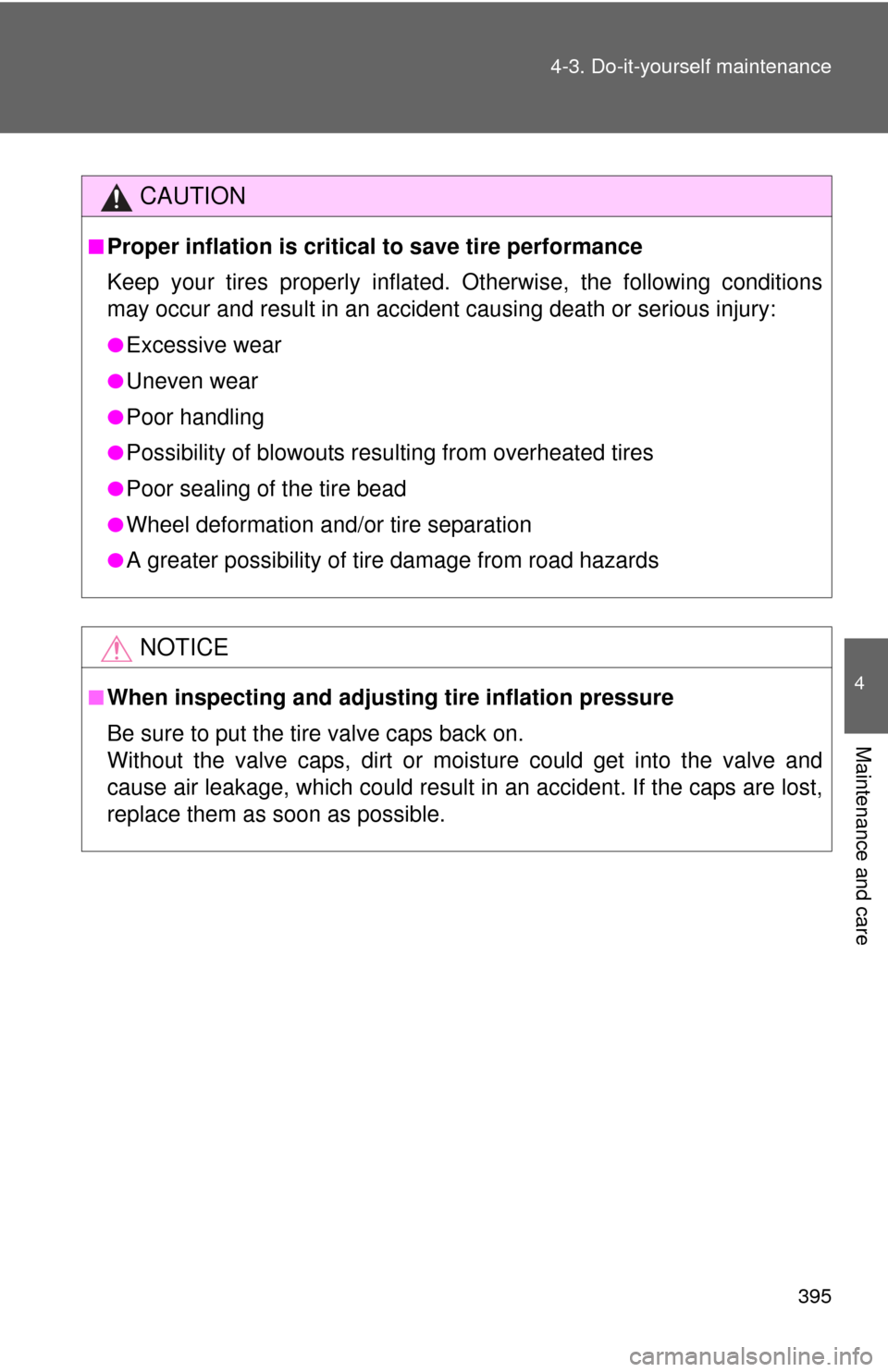
395
4-3. Do-it-yourself maintenance
4
Maintenance and care
CAUTION
■Proper inflation is critical
to save tire performance
Keep your tires properly inflated. Otherwise, the following conditions
may occur and result in an accident causing death or serious injury:
●Excessive wear
●Uneven wear
●Poor handling
●Possibility of blowouts resu lting from overheated tires
●Poor sealing of the tire bead
●Wheel deformation and/or tire separation
●A greater possibility of tire damage from road hazards
NOTICE
■When inspecting and adjusting tire inflation pressure
Be sure to put the tire valve caps back on.
Without the valve caps, dirt or mo isture could get into the valve and
cause air leakage, which could result in an accident. If the caps are lost,
replace them as soon as possible.
Page 402 of 563
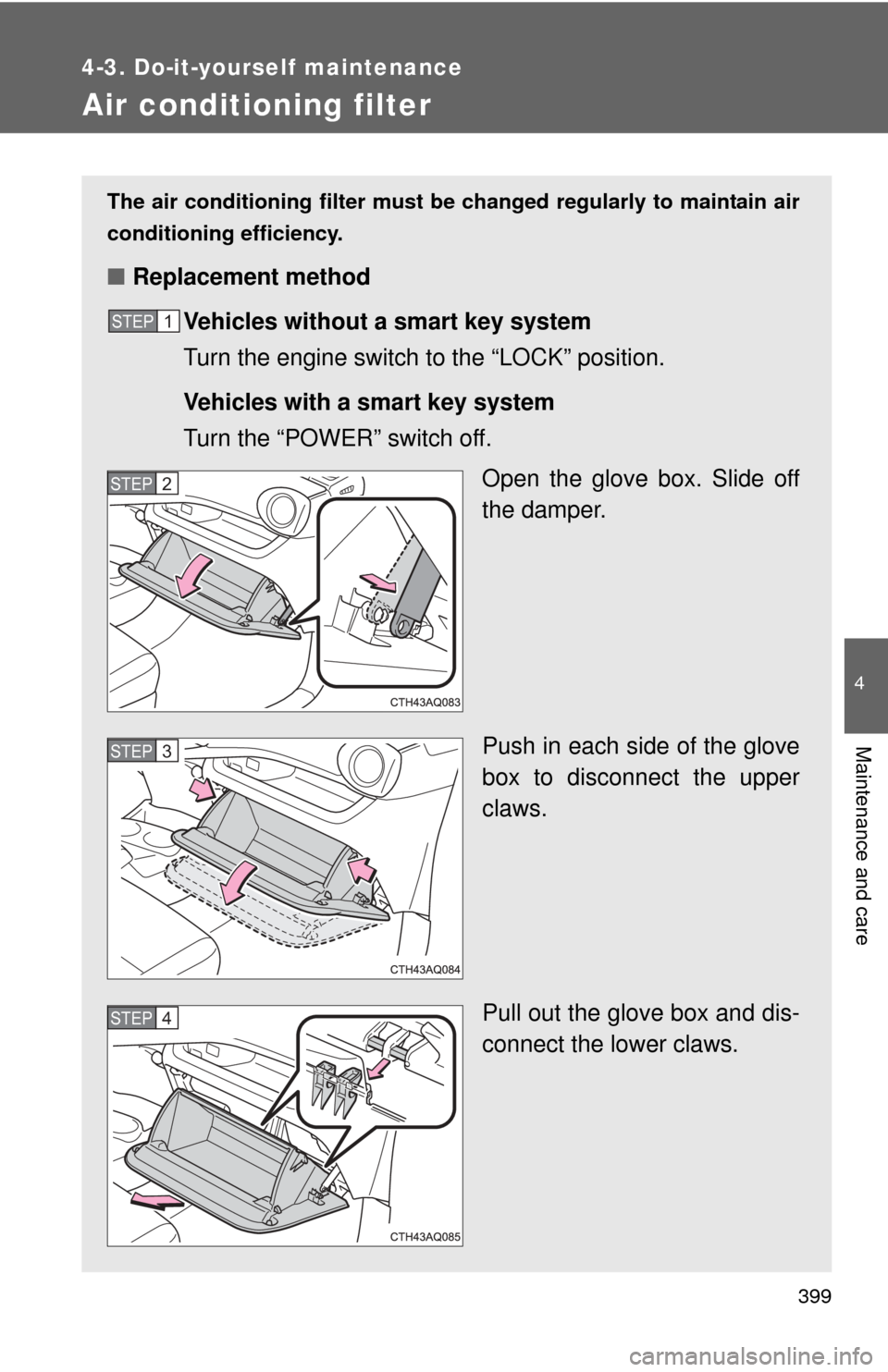
399
4-3. Do-it-yourself maintenance
4
Maintenance and care
Air conditioning filter
The air conditioning filter must be changed regularly to maintain air
conditioning efficiency.
■ Replacement method
Vehicles without a smart key system
Turn the engine switch to the “LOCK” position.
Vehicles with a smart key system
Turn the “POWER” switch off.
Open the glove box. Slide off
the damper.
Push in each side of the glove
box to disconnect the upper
claws.
Pull out the glove box and dis-
connect the lower claws.
STEP1
STEP2
STEP3
STEP4
Page 403 of 563
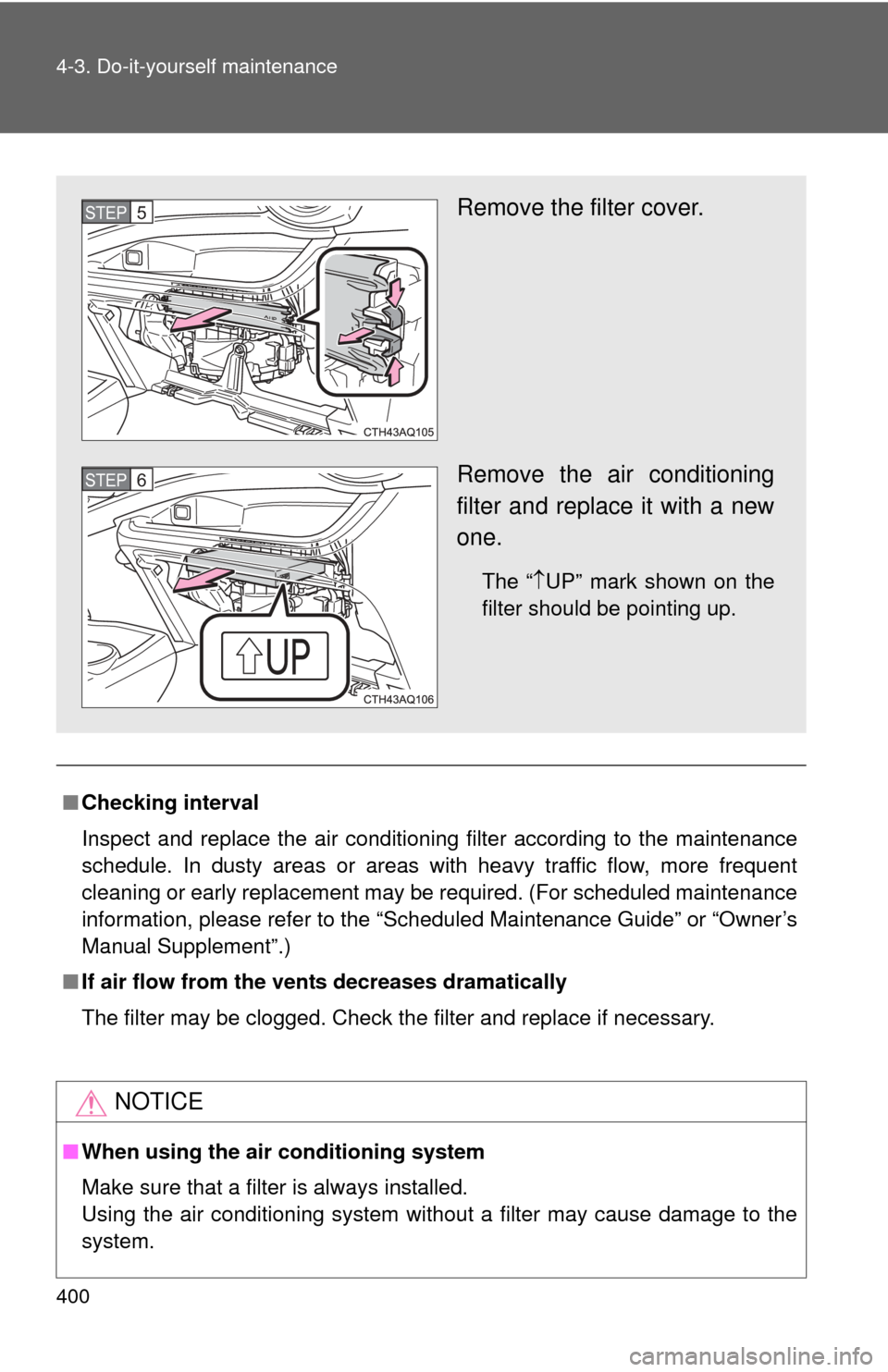
400 4-3. Do-it-yourself maintenance
■Checking interval
Inspect and replace the air conditioning filter according to the maintenance
schedule. In dusty areas or areas with heavy traffic flow, more frequent
cleaning or early replacement may be required. (For scheduled maintenance
information, please refer to the “Scheduled Maintenance Guide” or “Owner’s
Manual Supplement”.)
■ If air flow from the vents decreases dramatically
The filter may be clogged. Check the filter and replace if necessary.
NOTICE
■When using the air conditioning system
Make sure that a filter is always installed.
Using the air conditioning system without a filter may cause damage to the
system.
Remove the filter cover.
Remove the air conditioning
filter and replace it with a new
one.
The “ UP” mark shown on the
filter should be pointing up.
STEP5
STEP6
Page 413 of 563

410 4-3. Do-it-yourself maintenance
25 ECU-B NO.2 7.5 AAir conditioning system, gauge
and meters, occupant classifica-
tion system, tire pressure warning
system, starter system, smart key
system, power door lock system
26 AM2 7.5 A Starter system
27 STRG LOCK 20 A Starter system
28 ABS NO.2 10 A Brake system
29 IGCT-MAIN 30 A IGCT NO.2, IGCT NO.3, IGCT
NO.4, PCU, BATT FAN
30 D/C CUT 30 A DOME, ECU-B NO.1
31 PTC HTR NO.1 30 A PTC heater
32 PTC HTR NO.2 30 A PTC heater
33 FAN 30 A Electric cooling fan
34 PTC HTR NO.3 30 A PTC heater
35 DEF 30 A MIR HTR, rear window defogger
36 DEICER 20 A No circuit
37 BATT FAN 10 A Battery cooling fan
38 IGCT NO.2 10 A Hybrid system
39 IGCT NO.4 10 A Hybrid system
40 PCU 10 A Hybrid system
41 IGCT NO.3 10 A Hybrid system
42 MIR HTR 10 A Outside rear view mirror defoggers
FuseAmpereCircuit
Page 414 of 563
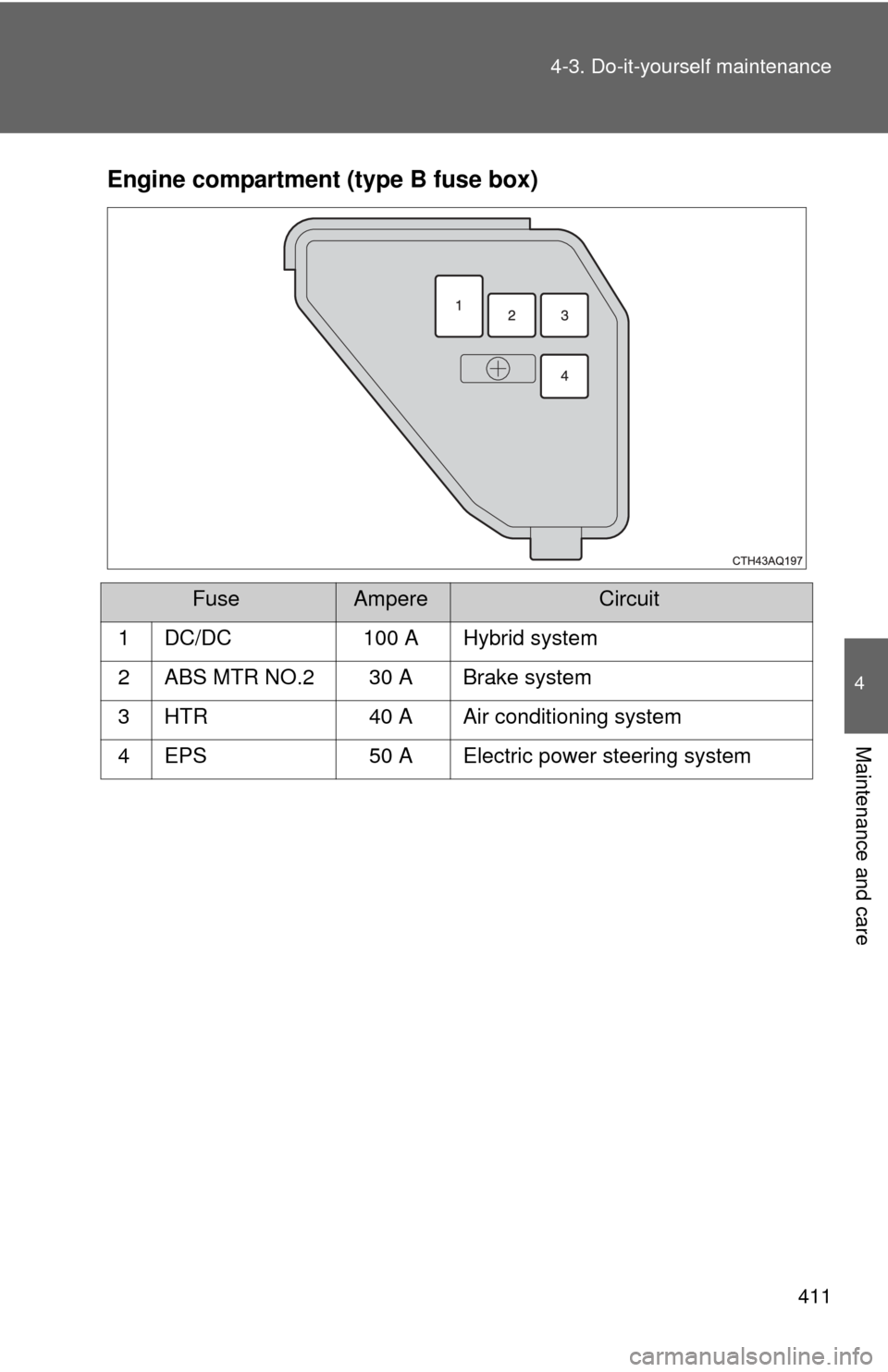
411
4-3. Do-it-yourself maintenance
4
Maintenance and care
Engine compartment (type B fuse box)
FuseAmpereCircuit
1 DC/DC 100 A Hybrid system
2 ABS MTR NO.2 30 A Brake system
3 HTR 40 A Air conditioning system
4 EPS 50 A Electric power steering system
Page 415 of 563
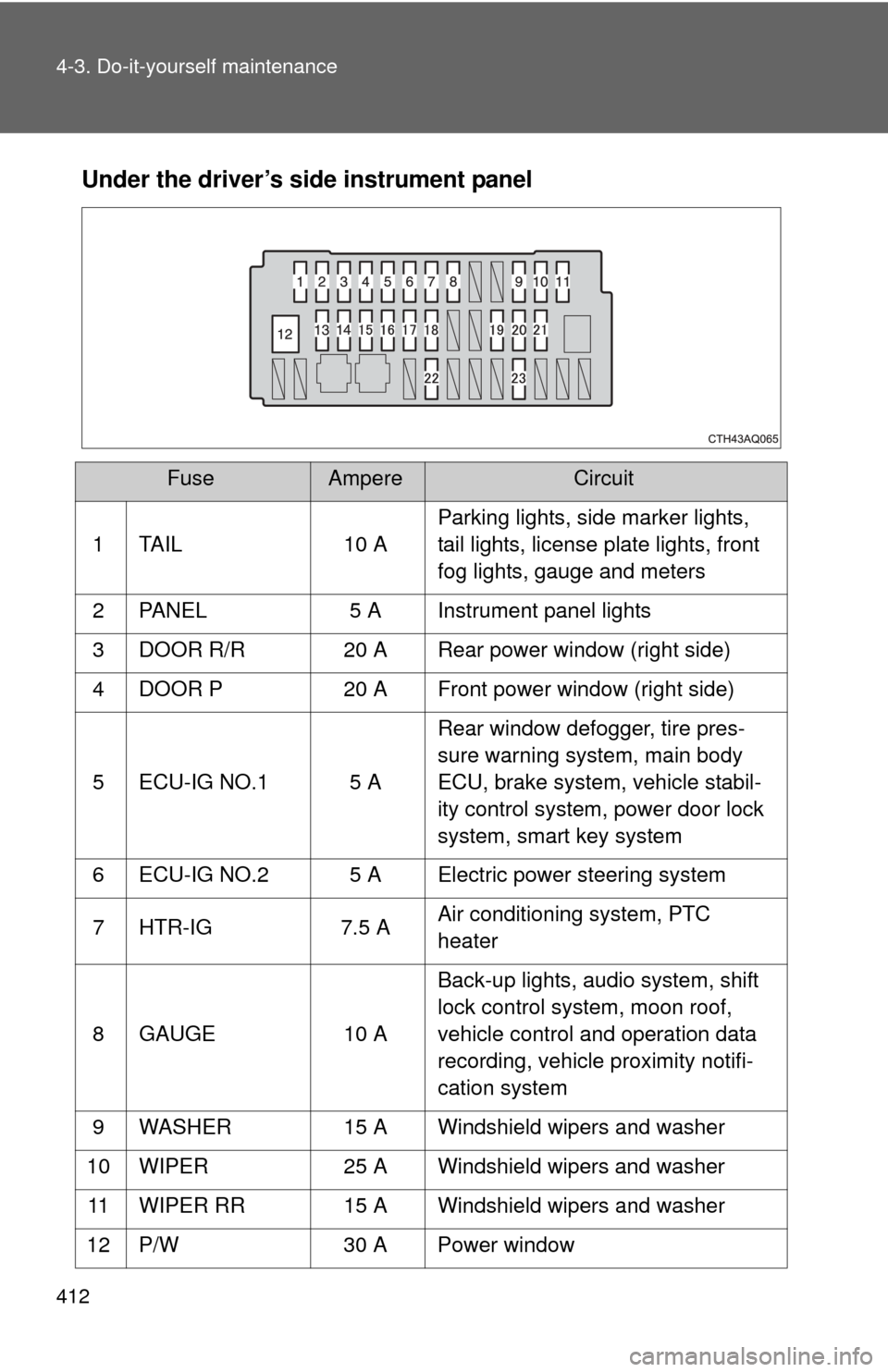
412 4-3. Do-it-yourself maintenance
Under the driver’s side instrument panel
FuseAmpereCircuit
1 TAIL 10 A Parking lights, side marker lights,
tail lights, license plate lights, front
fog lights, gauge and meters
2 PANEL 5 A Instrument panel lights
3 DOOR R/R 20 A Rear power window (right side)
4 DOOR P 20 A Front power window (right side)
5 ECU-IG NO.1 5 A Rear window defogger, tire pres-
sure warning system, main body
ECU, brake system, vehicle stabil-
ity control system, power door lock
system, smart key system
6 ECU-IG NO.2 5 A Electric power steering system
7HTR-IG 7.5 A Air conditioning system, PTC
heater
8 GAUGE 10 A Back-up lights, audio system, shift
lock control system, moon roof,
vehicle control and operation data
recording, vehicle proximity notifi-
cation system
9 WASHER 15 A Windshield wipers and washer
10 WIPER 25 A Windshield wipers and washer
11 WIPER RR 15 A Windshield wipers and washer
12 P/W 30 A Power window
Page 416 of 563
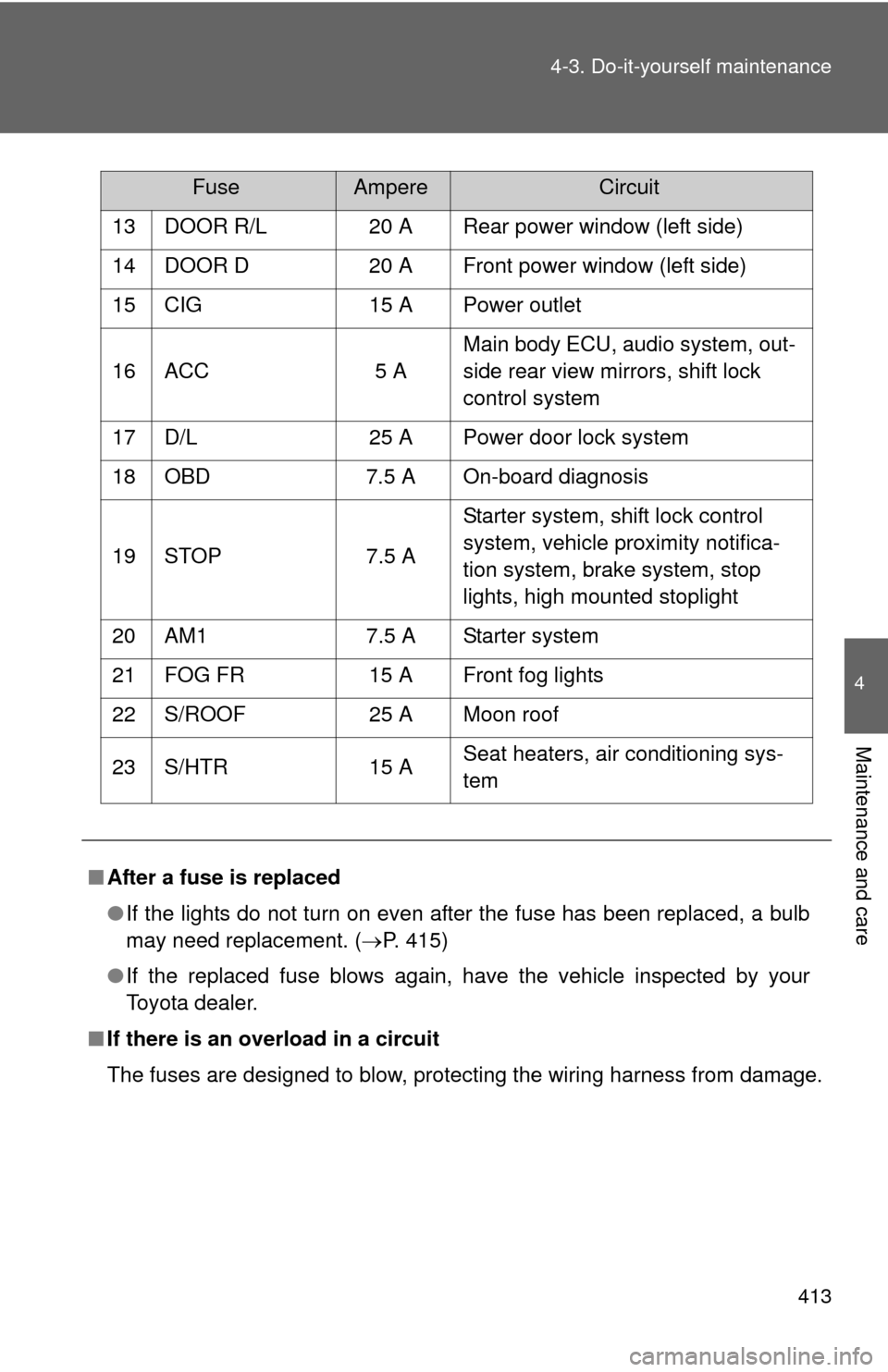
413
4-3. Do-it-yourself maintenance
4
Maintenance and care
13 DOOR R/L 20 A Rear pow
er window (left side)
14 DOOR D 20 A Front power window (left side)
15 CIG 15 A Power outlet
16 ACC 5 A Main body ECU, audio system, out-
side rear view mirrors, shift lock
control system
17 D/L 25 A Power door lock system
18 OBD 7.5 A On-board diagnosis
19 STOP 7.5 A Starter system, shift lock control
system, vehicle proximity notifica-
tion system, brake system, stop
lights, high mounted stoplight
20 AM1 7.5 A Starter system
21 FOG FR 15 A Front fog lights
22 S/ROOF 25 A Moon roof
23 S/HTR 15 A Seat heaters, air conditioning sys-
tem
■ After a fuse is replaced
●If the lights do not turn on even after the fuse has been replaced, a bulb
may need replacement. ( P. 415)
● If the replaced fuse blows again, have the vehicle inspected by your
Toyota dealer.
■ If there is an overload in a circuit
The fuses are designed to blow, protecting the wiring harness from damage.
FuseAmpereCircuit